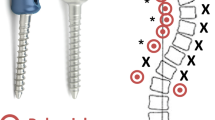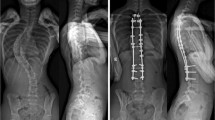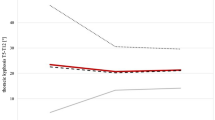Abstract
Purpose
Thoracic hypokyphosis following AIS correction may be associated with reduced lumbar lordosis with potential adverse effects on the global sagittal balance. In the present study, we were interested in how the amount of thoracic kyphosis influences the sagittal profile and balance in selective thoracic (STF) and thoracolumbar fusions.
Methods
Out of 154 patients, 86 patients had correction of AIS Lenke I or II with a side-loading pedicle screw system and completed a 2-year follow-up. Patient factors such as age, Risser grade, lowest and upper instrumented vertebra, and lumbar modifier were recorded. Coronal Cobb and sagittal parameters were measured using Surgimap. Statistical analysis according to distributions and multiple linear and logistic regressions was performed using STATA for Mac v13.
Results
In STF, logistic regression against post-operative change in SVA versus thoracic kyphosis allowed calculation of a critical thoracic kyphosis of 23° (ROC AUC 0.65, spec 0.70, sens 0.63), below which deterioration of the sagittal vertical axis is more likely (PPV 71.4%). Patients with hypokyphosis exhibited an increase in the SVA (pre-operative 7.2 ± 37.1 mm vs. 23.1 ± 27.6 mm at 2 years, p = 0.0164), whereas it was maintained from pre-operative to 2 years post-operative if thoracic kyphosis is above 23° (pre-operative 2.5 ± 28.9 mm vs. 5.4 ± 26.9 mm at 2 years, p = 0.579).
Conclusion
A critical thoracic kyphosis of 23° and more should be aimed for in hypokyphotic patients to potentially avoid post-operative sagittal plane deterioration with mechanical and likely also clinical consequences.
Graphic abstract
These slides can be retrieved under Electronic Supplementary Material.




Similar content being viewed by others
References
Bridwell KH (1999) Surgical treatment of idiopathic adolescent scoliosis. Spine 24:2607–2616
Majdouline Y, Aubin CE, Robitaille M, Sarwark JF, Labelle H (2007) Scoliosis correction objectives in adolescent idiopathic scoliosis. J Pediatr Orthop 27:775–781. https://doi.org/10.1097/BPO.0b013e31815588d8
La Grone MO (1988) Loss of lumbar lordosis. A complication of spinal fusion for scoliosis. Orthop Clin N Am 19:383–393
Abelin-Genevois K, Estivalezes E, Briot J, Sévely A, Sales de Gauzy J, Swider P (2015) Spino-pelvic alignment influences disc hydration properties after AIS surgery: a prospective MRI-based study. Eur Spine J 24:1183–1190. https://doi.org/10.1007/s00586-015-3875-4
de Jonge T, Dubousset JF, Illés T (2002) Sagittal plane correction in idiopathic scoliosis. Spine 27:754–760
Matsumoto H, Colacchio ND, Schwab FJ, Lafage V, Roye DP, Vitale MG (2015) Flatback revisited: reciprocal loss of lumbar lordosis following selective thoracic fusion in the setting of adolescent idiopathic scoliosis. Spine Deform 3:345–351. https://doi.org/10.1016/j.jspd.2015.01.004
Newton PO, Yaszay B, Upasani VV et al (2010) Preservation of thoracic kyphosis is critical to maintain lumbar lordosis in the surgical treatment of adolescent idiopathic scoliosis. Spine 35:1365–1370. https://doi.org/10.1097/BRS.0b013e3181dccd63
Takayama K, Nakamura H, Matsuda H (2009) Low back pain in patients treated surgically for scoliosis: longer than sixteen-year follow-up. Spine 34:2198–2204. https://doi.org/10.1097/BRS.0b013e3181b3f31f
Hayes MA, Tompkins SF, Herndon WA, Gruel CR, Kopta JA, Howard TC (1988) Clinical and radiological evaluation of lumbosacral motion below fusion levels in idiopathic scoliosis. Spine 13:1161–1167
Ilharreborde B, Morel E, Mazda K, Dekutoski MB (2009) Adjacent segment disease after instrumented fusion for idiopathic scoliosis: review of current trends and controversies. J Spinal Disord Tech 22:530–539. https://doi.org/10.1097/BSD.0b013e31818d64b7
Bernstein P, Hentschel S, Platzek I et al (2014) Thoracal flat back is a risk factor for lumbar disc degeneration after scoliosis surgery. Spine J 14:925–932. https://doi.org/10.1016/j.spinee.2013.07.426
Lowe TG, Lenke L, Betz R et al (2006) Distal junctional kyphosis of adolescent idiopathic thoracic curves following anterior or posterior instrumented fusion: incidence, risk factors, and prevention. Spine 31:299–302. https://doi.org/10.1097/01.brs.0000197221.23109.fc
Lonner BS, Ren Y, Newton PO et al (2017) Risk factors of proximal junctional kyphosis in adolescent idiopathic scoliosis—the pelvis and other considerations. Spine Deform 5:181–188. https://doi.org/10.1016/j.jspd.2016.10.003
Abelin-Genevois K, Sassi D, Verdun S, Roussouly P (2018) Sagittal classification in adolescent idiopathic scoliosis: original description and therapeutic implications. Eur Spine J 48:786. https://doi.org/10.1007/s00586-018-5613-1
Schwab FJ, Blondel B, Bess S et al (2013) Radiographical spinopelvic parameters and disability in the setting of adult spinal deformity. Spine 38:E803–E812. https://doi.org/10.1097/BRS.0b013e318292b7b9
Schwab F, Ungar B, Blondel B et al (2012) Scoliosis research society—schwab adult spinal deformity classification. Spine 37:1077–1082. https://doi.org/10.1097/BRS.0b013e31823e15e2
Yilgor C, Sogunmez N, Boissière L et al (2017) Global Alignment and Proportion (GAP) Score: development and validation of a new method of analyzing spinopelvic alignment to predict mechanical complications after adult spinal deformity surgery. J Bone Joint Surg 99:1661–1672. https://doi.org/10.2106/JBJS.16.01594
Somerville EW (1952) Rotational lordosis: the development of the single curve. J Bone Joint Surg 34-B:421–427
Ilharreborde B (2018) Sagittal balance and idiopathic scoliosis: does final sagittal alignment influence outcomes, degeneration rate or failure rate. Eur Spine J 27:48–58. https://doi.org/10.1007/s00586-018-5472-9
Clément JL, Pelletier Y, Solla F, Rampal V (2018) Surgical increase in thoracic kyphosis increases unfused lumbar lordosis in selective fusion for thoracic adolescent idiopathic scoliosis. Eur Spine J. https://doi.org/10.1007/s00586-018-5740-8
Senteler M, Weisse B, Snedeker JG, Rothenfluh DA (2014) Pelvic incidence–lumbar lordosis mismatch results in increased segmental joint loads in the unfused and fused lumbar spine. Eur Spine J 23:1384–1393. https://doi.org/10.1007/s00586-013-3132-7
Lonner BS, Lazar-Antman MA, Sponseller PD et al (2012) Multivariate analysis of factors associated with kyphosis maintenance in adolescent idiopathic scoliosis. Spine 37:1297–1302. https://doi.org/10.1097/BRS.0b013e318247e9a6
Holewijn RM, Schlösser TP, Bisschop A et al (2015) How Does Spinal Release and Ponte Osteotomy Improve Spinal Flexibility? The Law of Diminishing Returns. Spine Deform 3:489–495. https://doi.org/10.1016/j.jspd.2015.03.006
Luk KD, Vidyadhara S, Lu DS, Wong YW, Cheung WY, Cheung KM (2010) Coupling between sagittal and frontal plane deformity correction in idiopathic thoracic scoliosis and its relationship with postoperative sagittal alignment. Spine 35:1158–1164. https://doi.org/10.1097/brs.0b013e3181bb49f3
Pasha S, Cahill PJ, Dormans JP, Flynn JM (2016) Characterizing the differences between the 2D and 3D measurements of spine in adolescent idiopathic scoliosis. Eur Spine J 25:3137–3145. https://doi.org/10.1007/s00586-016-4582-5
Author information
Authors and Affiliations
Corresponding author
Ethics declarations
Conflict of interest
The authors declare no conflicts of interest related to this work.
Additional information
Publisher's Note
Springer Nature remains neutral with regard to jurisdictional claims in published maps and institutional affiliations.
Electronic supplementary material
Below is the link to the electronic supplementary material.
Rights and permissions
About this article
Cite this article
Rothenfluh, D.A., Stratton, A., Nnadi, C. et al. A critical thoracic kyphosis is required to prevent sagittal plane deterioration in selective thoracic fusions in Lenke I and II AIS. Eur Spine J 28, 3066–3075 (2019). https://doi.org/10.1007/s00586-019-06093-z
Received:
Revised:
Accepted:
Published:
Issue Date:
DOI: https://doi.org/10.1007/s00586-019-06093-z




